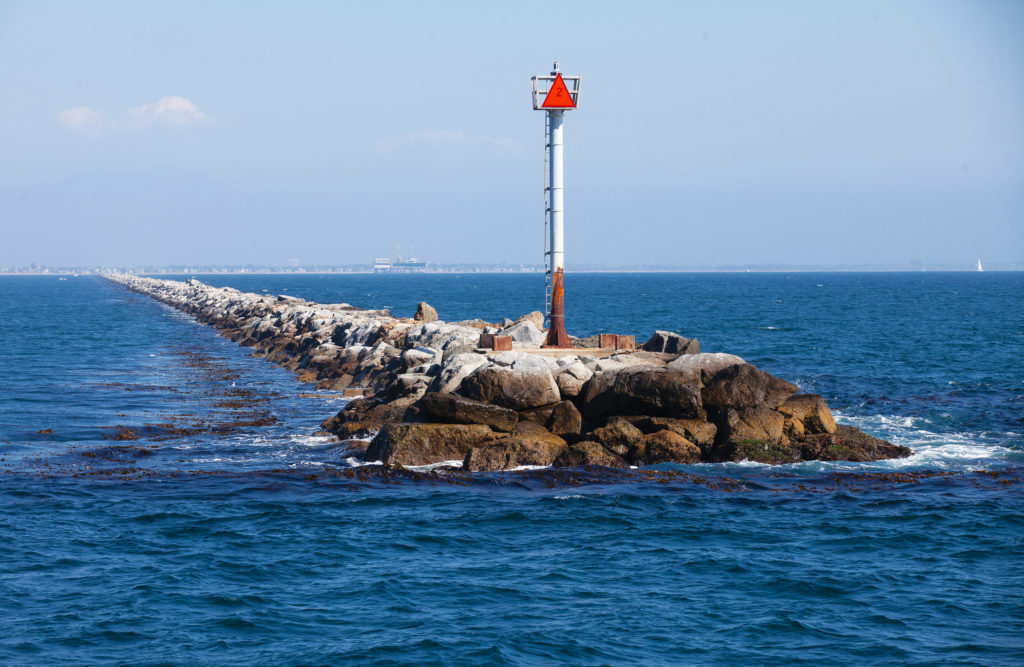A potential extension of a three-year study to improve Long Beach’s coastal ecosystem may also include an effort to further explore the feasibility of removing or modifying portions of the western side of the Long Beach breakwater, according to officials with the City of Long Beach and U.S. Army Corps of Engineers.
The city and the Army Corps of Engineers signed a federal cost share agreement to begin the East San Pedro Bay Ecosystem Restoration Study on January 20, 2016. The study, which reached its deadline earlier this year, was intended to improve ocean biodiversity and water quality in Long Beach.

Included in that research was the possibility of removing the Long Beach breakwater, one of three structures built by the U.S. Army along the coast to protect military naval ships during World War II. As a result, the breakwater reduced tidal flow in the Long Beach area.
Since the study began, city and corps officials have provided updates to the public about the study and its findings. Last September, Garcia announced six options being studied for the project. Included in these draft “alternatives,” as the Corps refers to them, were two options that explored modifications to the eastern and western ends of the breakwater.
A letter to the city last October from the U.S. Navy expressed concerns about modifying the breakwater, explaining that a nearby anchorage necessary for weapon and munition transfers would be negatively impacted. The study’s proposed eastern breakwater modification alternative directly impacts the Navy’s anchorage, rendering that option unfeasible, according to Diana Tang, the city’s manager of government affairs.
However, Tang said city officials see potential in the western breakwater alternative and wish to expand its analysis to determine the feasibility of modifying that end of the structure and avoid impacting maritime operations, including those at the Port of Long Beach. Combined with the Port of Los Angeles, the twin ports are the largest maritime trade gateway in the United States. Their infrastructure is protected by the breakwater.
The initial proposal did not determine if modifying the western breakwater would also impact the Navy’s navigational accessibility. Tang said the Corps and the city will work to mitigate those issues if the expanded study reveals potential interference. “For that reason, we’re focusing our efforts on the western end, which is located outside of the explosive anchorage arc,” Tang said. “We’re hoping that because it’s located outside of the arc, that there might be something that is possible, but we are not sure yet.”
The western breakwater plan would implement two 1,000-foot notches, or indentations, on that end of the structure, according to the study’s draft alternatives document. “Stones removed from the breakwater would be reused to build protective structures around the oil islands, Pier J structures and the parking lot near Junipero Beach,” reads the September 10, 2018, public document detailing all the project alternatives.
Tang clarified that the potential East San Pedro Ecosystem Restoration Study extension and the proposed analysis expansion of the western breakwater modification are separate efforts. “The separate aspect to it is that the city is conducting analysis on [its] own,” said Chris Lee, project manager with the Army Corps of Engineers. The results of the proposed expansion project will be incorporated into the study when it’s concluded, he noted.
Lee said an “exemption request” must be submitted to the Corps’ headquarters in Washington D.C. to extend the East San Pedro Bay Ecosystem Restoration Study past the three-year mark. A timeline for the extension request is unclear. “We are currently still working with the city on developing the schedule, as well as the cost estimate that would cover the extended time and additional analysis,” Lee said.
According to Lee, the analysis of the western breakwater plan will be at the city’s expense, while the extension of the East San Pedro Bay Ecosystem Restoration Study will be split between the Army Corps of Engineers and the City of Long Beach. The city’s Tidelands Fund is assisting in financing the study’s extension. The initial three-year analysis was $3 million.
The cost impact of extending the study and expanding the analysis of the western end of the breakwater is unclear at this time. “Anything that’s beyond what we currently have a budget for [would need the council’s] authorization,” Tang said. “We are going through our budget process with the city now, so it’s trying to figure all that out. And we don’t have a timeline for that.”
Raina Fulton, acting chief of the Army Corps of Engineers’ planning division, said the Corps’ headquarters allocates funds for projects on a case-by-case basis.
Tang said the city’s goal in the study has been to improve the quality of its beaches. “The city is interested in the incidental recreational benefits, improved water quality and improved value of our beaches – all without impacting national security and navigational operations within the bay,” she said.
Eileen Takata, lead planner of the East San Pedro Ecosystem Restoration Study, said the Corps’ priority for the project is to provide “benefits to habitat.” While the western breakwater alternative will be a major point of focus, Takata said all other alternatives are still on the table.
In addition to the two breakwater modification options and a “no action” alternative, the study proposals included kelp, reef and scarce habitat restoration plans. “I hope we select the option that best restores our habitat,” she said. “It remains to be seen what the tentatively selected plan is. Restoration is the goal.”
Officials said there is no timeline for when the potential study extension and expansion will be approved.
